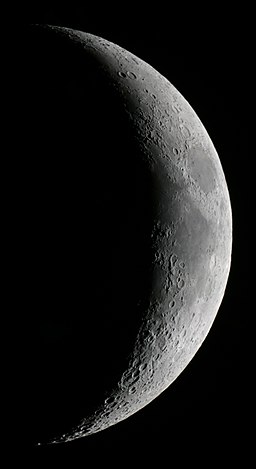If you saw a painting of a scene that included a coniferous tree filled with blossoms or fruit, it would be incongruous, and unless it was done intentionally it would probably somewhat spoil the painting. Similarly, if shadows are drawn incorrectly it can distract from the image, which is why shading is taught to aspiring artists early on. Unfortunately, these lessons often don't extend to the shading of the moon, and representations of the moon in contemporary art are often (or more likely usually) incorrect. (Check out these tips to learn how to draw the moon correctly!)
The moon is most often depicted as a crescent, and there are two problems that frequently pop up. The first is that the real crescent moon is lit from the very top to very bottom:
 |
| Crescent Moon by Thomas Bresson from the Wikimedia Commons |
Many artistic depictions of the crescent moon extend considerably past the top and bottom of the moon:
 |
Golden Crescent Moon by Dcubillas from Wikimedia Commons |
Once you know a bit about the moon, incorrect depictions jump right out at you, and can spoil the art. For example, in the generally excellent "Conqueror" series of books about Ghengis Khan, the moonrise or moonset were often incorrectly described, which isn't so pleasant in "historical fiction". In one particularly bad case, the crescent moon rose shortly after the sun set (not possible!), and the opposing general took it to be a good omen. Since the plot could hang on a detail like this, it's unfortunate when more care isn't taken.
I have suspected for quite a while that before the advent of electric lighting, people would have been more familiar with the comings and goings of the moon, and it's made me wonder if depictions of the moon in art are were more likely to be correct in the past.
Over Easter, I visited St Mary's Church in Stralsund Germany to listen to an organ concert. While we waited for the concert to begin, I took photos of two of the church's paintings that caught my eye because of the presence of the crescent moon. The first photo shows a burial at sea:
 |
| "Seebestattung" (Burial at sea) - unknown artist, ca 1900, oil on canvas |
I don't know the name or any details of the second image:
Here you can see that the crescent moon is again correctly depicted, with the lit part running exactly from top to bottom, and the moon "pointing" straight to the sun. Some artistic license is used here, because stars are shown with the moon while the sun is up, but (I think) the two sides represent before and after Adam and Eve ate from the tree. (It's also interesting to me that living in Eden is depicted as being in the night, while being cast out of Eden is under the sun.)
Of course, artists are free to depict the moon (and pine trees) any way they want. But if it's going to be depicted differently from nature, artists should be aware that some segment of the population will note the incongruity, and it may spoil the work for them.

I'm confused about the sunset being in the east. Is that correct?
ReplyDeleteThank you very much for pointing that out. It was a typo, and it's now corrected.
ReplyDelete